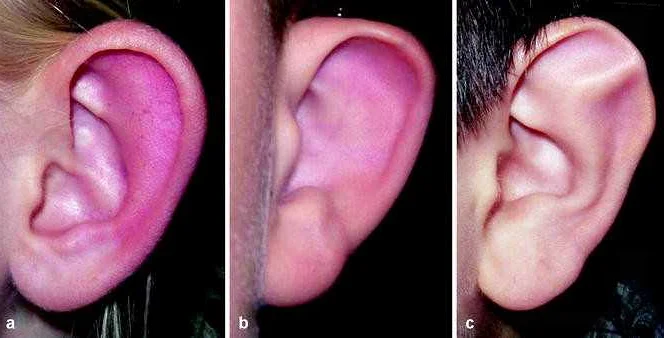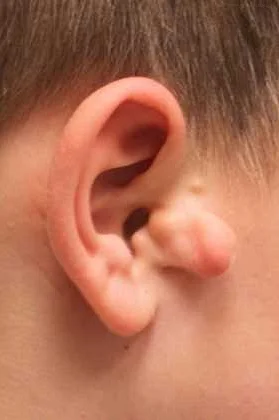Developmental anomalies of the external ear
Содержимое
Developmental anomalies of the external ear are congenital abnormalities that affect the structure and shape of the outer ear. This article discusses various types of external ear anomalies, including microtia, anotia, and preauricular pits, and their causes, symptoms, diagnosis, and treatment options. Understanding these anomalies can help healthcare professionals provide appropriate care and support to individuals with these conditions.
Developmental anomalies of the external ear refer to the abnormalities that occur during the formation and growth of the outer part of the ear. These anomalies can affect the shape, size, position, or structure of the external ear, leading to cosmetic or functional issues. They can range from minor variations to significant deformities, and may occur in isolation or as part of a syndrome.
The causes of developmental anomalies of the external ear are diverse and can include genetic factors, prenatal infections, exposure to certain medications or substances, as well as other environmental factors. Genetic mutations or alterations during embryonic development can disrupt the normal formation of the ear, leading to anomalies. Additionally, certain medical conditions or syndromes can be associated with external ear abnormalities.
The symptoms of developmental anomalies of the external ear can vary depending on the specific anomaly and its severity. Common symptoms may include malformed or absent ear structures, such as misshapen pinnae (outer ear), absent ear canals, or abnormal ear positioning. These anomalies can be unilateral (affecting one ear) or bilateral (affecting both ears). In some cases, hearing loss or auditory problems may be present.
The treatment options for developmental anomalies of the external ear depend on various factors, including the type and severity of the anomaly, the age of the individual, and the desired outcome. Mild anomalies may not require any treatment, while more significant abnormalities may benefit from surgical interventions. Surgical techniques can help reshape and reconstruct the external ear to improve its appearance and function. In some cases, hearing aids or other assistive devices may be recommended to address hearing loss or auditory issues.
Overall, developmental anomalies of the external ear can have a significant impact on a person’s appearance, self-esteem, and communication abilities. It is important for individuals with these anomalies to consult with healthcare professionals who specialize in ear, nose, and throat disorders to determine the appropriate management and treatment options.
Developmental Anomalies of the External Ear
The external ear, also known as the auricle or pinna, is the visible part of the ear that helps collect and funnel sound waves into the ear canal. Developmental anomalies of the external ear refer to structural abnormalities that occur during the early stages of fetal development.
These anomalies can range from minor variations in ear shape to more significant defects that can affect hearing and overall ear function. Some common developmental anomalies of the external ear include:
- Microtia: a condition where the external ear is small or not fully developed
- Anotia: a complete absence of the external ear
- Prominent ears: ears that stick out more than normal
- Stahl’s ear: a condition where the ear has an extra fold or pointy shape
- Cryptotia: a condition where the upper part of the ear is hidden under the scalp
These anomalies can occur due to a variety of factors, including genetic mutations, exposure to certain medications or chemicals during pregnancy, or as part of a syndrome or genetic condition. Some anomalies may be noticed at birth, while others may become more apparent as a child grows.
Depending on the severity of the anomaly and its impact on hearing and overall ear function, treatment options may vary. In some cases, no treatment may be necessary if the anomaly does not cause any functional problems. However, for more significant anomalies, surgical intervention may be recommended to correct the structural defect and improve hearing if necessary.
It is important for individuals with developmental anomalies of the external ear to seek medical evaluation and guidance from a healthcare professional specializing in ear, nose, and throat conditions. They can provide a thorough diagnosis, discuss treatment options, and offer support and resources for individuals and their families.
Causes of Developmental Anomalies

Developmental anomalies of the external ear can occur due to various factors, including genetic mutations, environmental factors, and certain medical conditions. These anomalies can affect the shape, size, and position of the external ear.
Genetic mutations are one of the most common causes of developmental anomalies. These mutations can be inherited from one or both parents or can occur spontaneously. They can result in abnormalities in the formation of the ear cartilage or the development of ear structures.
Environmental factors, such as exposure to certain drugs or chemicals during pregnancy, can also contribute to the development of ear anomalies. For example, exposure to thalidomide, a medication used to treat certain conditions, has been linked to the development of ear abnormalities.
Certain medical conditions can also increase the risk of developmental anomalies of the external ear. For instance, conditions like Treacher Collins syndrome and Goldenhar syndrome are known to be associated with ear malformations. These conditions are typically caused by genetic mutations that affect the normal development of the face and skull.
In some cases, the exact cause of developmental anomalies of the external ear may not be known. However, ongoing research is being conducted to better understand the underlying factors contributing to these anomalies.
It’s important to note that the development of external ear anomalies is not necessarily preventable. However, early detection and intervention can help in managing the condition and improving the overall quality of life for individuals affected by these anomalies.
Symptoms of Developmental Anomalies
Developmental anomalies of the external ear can result in various symptoms, depending on the specific condition present. Some common symptoms include:
- Abnormal shape or size of the ear
- Missing or underdeveloped external ear structures
- Deformed or asymmetrical ear
- Protruding or prominent ear
- Low-set or high-set ear
- Incomplete or absent ear canal
- Abnormalities in the earlobe
In addition to these physical symptoms, individuals with developmental anomalies of the external ear may also experience functional issues, such as hearing loss or difficulty with sound localization. The severity of symptoms can vary greatly, from mild cosmetic concerns to significant functional impairments.
If you or your child have any of these symptoms, it is important to consult with a medical professional for a proper diagnosis and appropriate treatment options. Early intervention and treatment can help manage the symptoms and improve the overall quality of life for individuals with developmental anomalies of the external ear.
Treatment for Developmental Anomalies

Developmental anomalies of the external ear can vary in severity and may require different treatment approaches. The specific treatment options depend on the type and extent of the anomaly and the individual’s overall health and preferences.
In cases where the anomaly does not cause any functional or cosmetic issues, treatment may not be necessary. However, regular monitoring by a healthcare professional is important to ensure that any changes or complications are detected early.
If the anomaly affects the function or appearance of the ear, treatment options may include:
| Surgical intervention: | A surgical procedure may be recommended to correct the anomaly and restore normal ear function and appearance. The specific surgical technique will depend on the type and severity of the anomaly. In some cases, multiple surgeries may be required to achieve the desired outcome. |
| Hearing aids: | If the developmental anomaly affects the hearing ability, hearing aids may be prescribed to improve auditory function. These devices can help amplify sound and improve the individual’s ability to hear and communicate. |
| Prosthetic devices: | In cases where the external ear is severely malformed or missing, prosthetic devices may be used to replace or supplement the missing or deformed ear. These devices are custom-made to match the individual’s natural ear shape and color. |
| Speech therapy: | If the developmental anomaly affects speech and language development, speech therapy may be recommended. Speech therapists can provide exercises and techniques to improve articulation and communication skills. |
| Counseling and support: | Living with a developmental anomaly of the external ear can be emotionally challenging. Counseling and support groups can provide individuals and their families with the necessary emotional support and guidance to cope with the physical and psychological effects of the anomaly. |
It is important to consult with a healthcare professional specializing in ear disorders to determine the most appropriate treatment plan for each individual case. The goal of treatment is to improve the function and appearance of the ear, as well as the overall quality of life of the affected individual.
Risks and Complications
Developmental anomalies of the external ear can present various risks and complications for affected individuals. Some of the potential risks and complications include:
1. Hearing loss: Depending on the severity of the anomaly, individuals may experience hearing impairment or complete deafness in one or both ears. This can significantly impact their ability to communicate and interact with others.
2. Speech and language difficulties: The external ear plays a crucial role in the formation and transmission of sound waves, which are essential for speech and language development. Anomalies in the external ear can lead to speech and language difficulties, making it challenging for individuals to express themselves effectively.
3. Psychological and social impact: Living with an external ear abnormality can have a significant psychological and social impact on affected individuals. They may experience feelings of self-consciousness, low self-esteem, and social isolation due to their physical appearance.
4. Increased susceptibility to ear infections: Certain developmental anomalies of the external ear can create an environment that is more prone to ear infections. The abnormal shape or structure of the ear can hinder proper drainage of fluids, leading to the accumulation of bacteria and increased risk of infection.
5. Surgical complications: In cases where surgical intervention is required to correct the anomaly, there are potential risks and complications associated with the procedure. These may include infection, bleeding, scarring, and anesthesia-related risks.
It is important for individuals with developmental anomalies of the external ear to seek appropriate medical evaluation and intervention to minimize these risks and complications. Early intervention and management can greatly improve the outcomes and overall quality of life for affected individuals.